For most digital marketing agencies, outsourcing SEO to a white label partner begins as a capacity solution — a way to fulfill more projects without expanding the internal team. But here’s the problem: outsourcing without feedback is just delegation, not collaboration.
Agencies often end up in a cycle of repeated deliverables, inconsistent results, and “firefighting” misalignments. The real growth happens when you turn that outsourced partnership into a continuous learning system — where every campaign teaches both teams something new, improving future performance and client satisfaction.
According to a 2024 Databox survey, 57% of agencies report that collaboration and reporting are their top operational time sinks. However, agencies that actively build structured feedback loops cut project turnaround times by up to 25% and see up to 30% higher client retention.
A well-engineered feedback loop transforms SEO outsourcing from a vendor transaction into an extension of your agency’s intellectual capital — where each iteration compounds results.
The Importance of a Feedback Loop in SEO Partnerships
Agencies often turn to white label SEO providers to tap into specialized expertise and scale their service offerings. While outsourcing can provide immediate capacity and technical know-how, many agencies struggle to sustain a continuous learning process that adapts to shifting client needs, industry trends, and search engine updates. Without a structured feedback system, outsourced efforts can remain siloed, limiting both performance and long-term growth.
A well-implemented feedback loop changes that dynamic. It ensures that both your internal team and the white label SEO provider stay aligned, responsive, and focused on measurable outcomes. By fostering regular communication, shared accountability, and data-driven decision-making, a feedback loop transforms SEO efforts from routine execution into a cycle of continuous improvement.
Key Benefits of a Strong Feedback Loop
- Accelerated Client Wins: Quickly identifying and addressing performance gaps allows agencies to optimize campaigns faster, resulting in more immediate improvements for clients.
- Enhanced Client Retention: Consistently delivering measurable results builds trust and satisfaction, strengthening long-term client relationships and encouraging renewals.
- Operational Efficiency: Clear communication channels, structured processes, and defined roles reduce misunderstandings and delays, enabling teams to work more effectively.
- Data-Driven Decision Making: Continuous feedback provides real-time insights, allowing agencies to refine strategies proactively rather than reactively.
By investing in a structured feedback loop, agencies not only improve campaign outcomes but also create a framework that scales knowledge, reduces friction, and supports sustainable growth.
What Constitutes an Effective Feedback Loop?
A “feedback loop” is not just about weekly check-ins or messages. It’s a living system that collects data, synthesizes insights, prioritizes actions, and repeats — with accountability built in.
Think of it as a six-step operational flywheel:
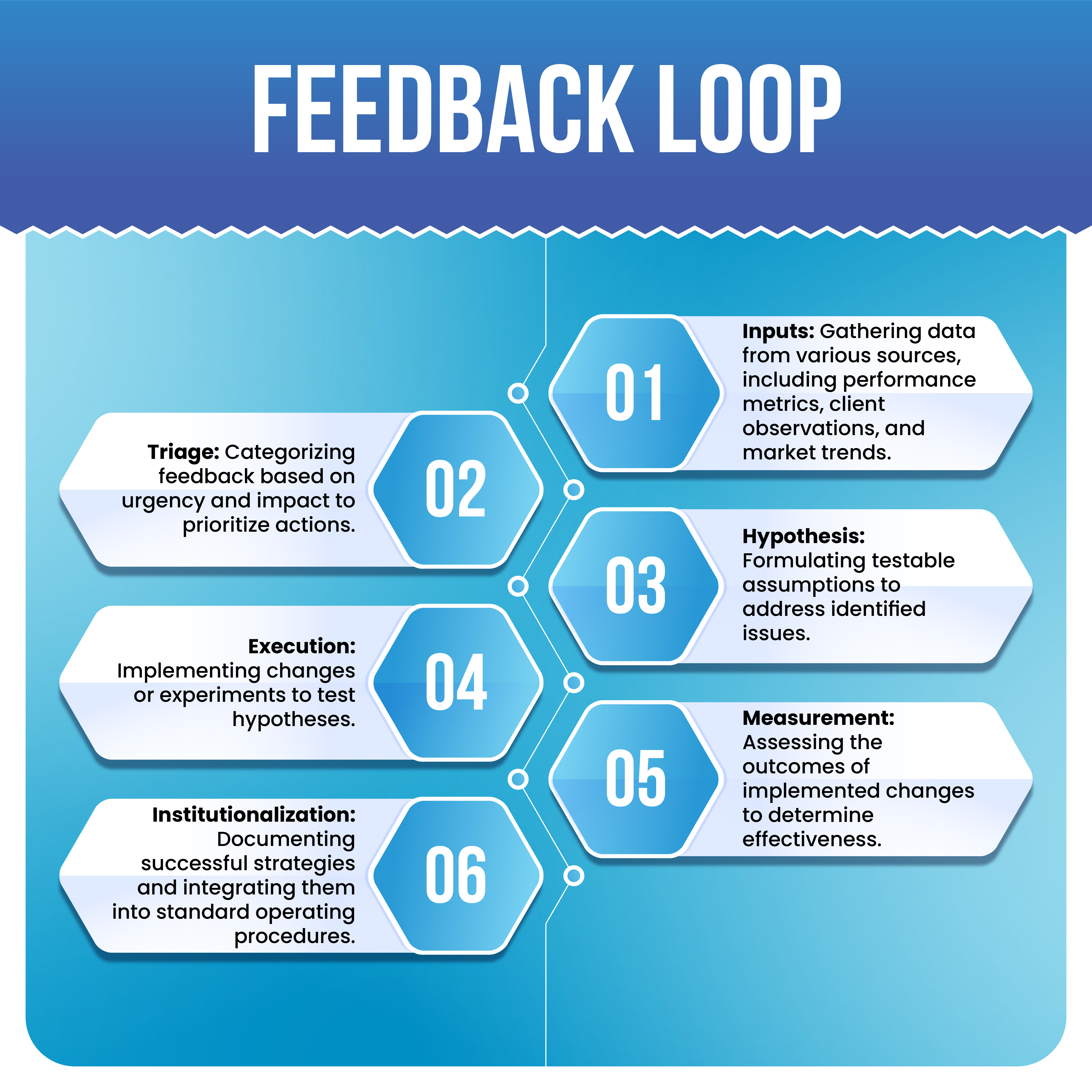
This cyclical process ensures that both teams are continuously learning and adapting, leading to sustained improvements in SEO performance.
Types of Feedback You Must Capture (and Why Each Matters)
Different kinds of feedback drive different insights. Agencies that treat all feedback equally often drown in noise — while those that structure it strategically turn chaos into clarity.
Here are five essential feedback streams:
- Performance Feedback: Quantitative data such as click-through rate (CTR), impressions, rankings, and conversion metrics.
- Experience Feedback: Qualitative insights from clients and internal teams regarding user experience and satisfaction.
- Process Feedback: Observations about workflow efficiencies or bottlenecks, including issues with SLAs or content review cycles.
- Creative Feedback: Input on messaging, tone, and calls to action that resonate with the target audience.
- Market Feedback: Information on competitor activities, industry trends, and regulatory changes that may impact SEO strategy.
Each type of feedback deserves its own capture format — form submissions for client input, call notes for qualitative context, automated tags for performance data.
The Point: structured collection is the foundation for structured improvement.
Design Patterns for Bullet-Proof Feedback Loops
To ensure the feedback loop is effective and actionable, consider the following design patterns:
- Single Source of Truth (SSOT): Maintain a centralized repository for all SEO-related data and documents to ensure consistency and accessibility.
- Event-Driven Feedback Ingestion: Implement automated systems to capture feedback in real time, reducing delays and ensuring timely responses.
- Triage Matrix (Impact × Effort): Develop a system to evaluate feedback based on its potential impact and the effort required to address it, facilitating efficient prioritization.
- Feedback Contracts: Establish clear agreements outlining the types of feedback accepted, expected response times, and criteria for resolution.
- Data Schema Standardization: Agree on consistent definitions for key metrics to prevent misunderstandings and ensure accurate reporting.
The more standardized the feedback system, the less interpretation is required. That clarity accelerates improvement cycles and fosters trust between teams.
Cadence & Governance — What to Run, How Often, and Who Owns It
Regular and structured interactions between teams are essential for maintaining an effective feedback loop:
- Daily: Monitor automated alerts for anomalies such as traffic dips or crawl errors.
- Weekly: Conduct brief triage sessions to review new feedback and assign responsibilities.
- Biweekly: Plan and execute mini-sprints to test new strategies or address identified issues.
- Monthly: Review outcomes, assess KPI progress, and gather client feedback to inform future actions.
- Quarterly: Hold strategic retrospectives to evaluate long-term trends and update roadmaps accordingly.
Assign ownership across three critical roles:
- Agency Liaison: client-facing strategist prioritizing commercial value.
- Partner Delivery Lead: white label SEO team lead, ensuring timely execution.
- Data Steward: custodian of consistent metrics and analytics integrity.
This cadence ensures structure, agility, and accountability.
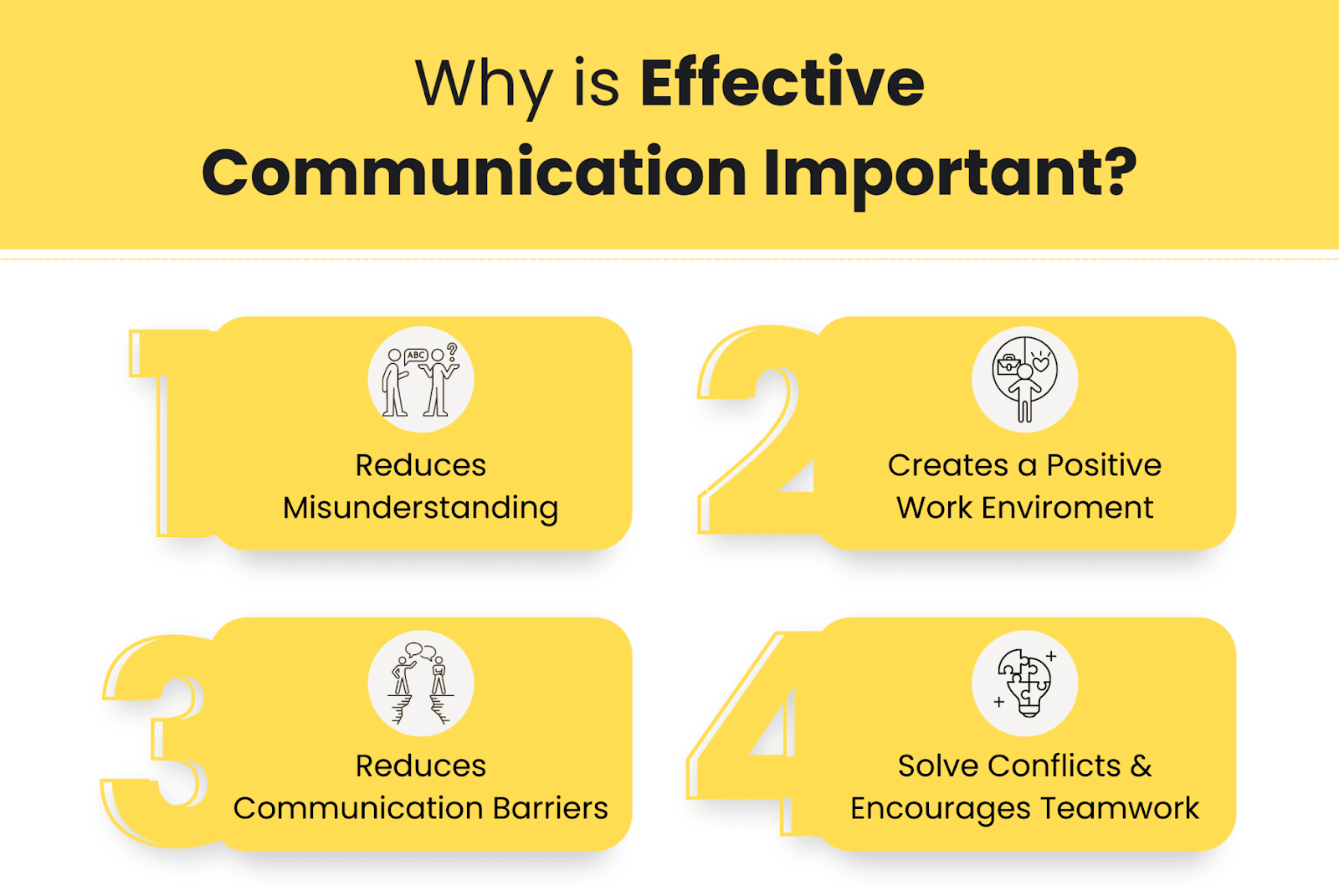
Experimentation Framework - Turning Feedback into Measurable Improvements
Transforming feedback into actionable improvements requires a structured approach to experimentation:
- Hypothesis Development: Clearly define the expected outcomes of proposed changes to set measurable goals.
- Testing: Begin with small-scale tests to minimize risk, gradually scaling successful strategies.
- Run Controlled Rollouts: Use feature flags or staged deployment for on-page changes — ensures rapid rollback if metrics dip.
- Failure Post-Mortems: Document root causes, hypothesis validity, and next steps. Learning from failed experiments is the essence of continuous improvement.
This system turns your agency–client relationship into a data-driven innovation pipeline instead of a task handoff process.
Measuring Success and Attribution - Proving the Loop Moved the Needle
1. Portfolio & Client KPIs
- Organic traffic and lead growth
- Keyword ranking velocity
- Time to first-page ranking
- Retention and renewal rate
2. Signal-Level Metrics
- Reduction in crawl errors
- Indexation speed
- Internal link equity changes
- CTR improvements post-content edits
3. Attribution & Reporting
- Use time-decay or multi-touch attribution to connect SEO influence across channels.
- Always compare against baseline and measure deltas — what changed, by how much, and why.
According to Zippia, organizations with structured feedback systems see 15–20% higher productivity and improved cross-functional engagement.
In SEO, that translates into faster optimization cycles and predictable ROI.
Fostering a Feedback-Oriented Culture
A successful feedback loop is supported by a culture that values continuous improvement:
- Shared KPIs: Align incentives between the agency and SEO provider to promote mutual success.
- Blameless Post-Mortems: Encourage learning from failures without assigning blame to foster a growth mindset.
- Knowledge Sharing: Implement systems to document and share successful strategies and insights across teams.
- Client-Centric Training: Ensure that all team members understand client objectives and outcomes to align efforts effectively.
Continuous improvement is 70% process, 30% culture — and the culture part determines long-term sustainability.
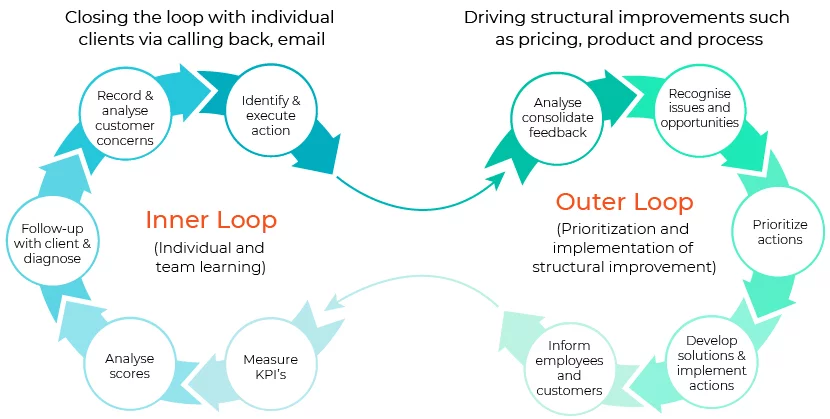
Image Source: Acuity Knowledge Partners
Common Pitfalls and How to Avoid Them?
Agencies should be aware of potential challenges in the feedback process:
- Feedback Overload: Too much feedback without action can lead to confusion and inaction. Implement triage systems to prioritize effectively.
- Metric Drift: Misaligned definitions can cause disagreements. Standardize data definitions to ensure consistency.
- Analysis Paralysis: Overanalyzing data can delay decision-making. Limit the number of concurrent experiments to maintain focus.
- Knowledge Gaps: Without proper documentation, valuable insights can be lost. Regular knowledge transfer sessions are essential.
When prevented early, these pitfalls turn your partner relationship from reactive to proactive.
A Practical Example: 8-Week Feedback Cycle
Consider a scenario where a client reports a 40% drop in leads from a specific city:
- Week 0: Gather initial feedback and identify potential issues.
- Week 1: Conduct triage and hypothesize that indexation delays and broken schema markup are contributing factors.
- Week 2: Implement changes on a small set of pages.
- Weeks 3–4: Measure the impact, observing a 12% increase in click-through rates.
- Week 5: Expand the changes to a broader set of pages.
- Week 7: Review cross-channel effects, noting improvements in PPC performance.
- Week 8: Conduct a retrospective, document the process, and plan for future optimizations.
Through this iterative process, the agency successfully addresses the client's concerns, leading to improved performance and satisfaction.
How DashClicks Facilitates Continuous Feedback and Growth?
DashClicks offers comprehensive white label SEO services and a platform that supports the establishment of effective feedback loops:
- Real-Time Analytics: Centralized dashboards provide live data on keywords, backlinks, and deliverables, ensuring transparency and timely insights.
- Automated Feedback Channels: In-platform tagging and revision requests streamline the process of capturing and acting on feedback.
- Pattern Recognition: The platform identifies recurring trends, enabling the refinement of strategies and playbooks.
- Client Retention Tools: Transparent reporting and consistent improvements help build trust and encourage client renewals.
- Seamless Integrations: DashClicks integrates with tools to facilitate smooth collaboration between teams.
By leveraging DashClicks, agencies can transform their SEO partnerships into dynamic, feedback-driven engines of growth.
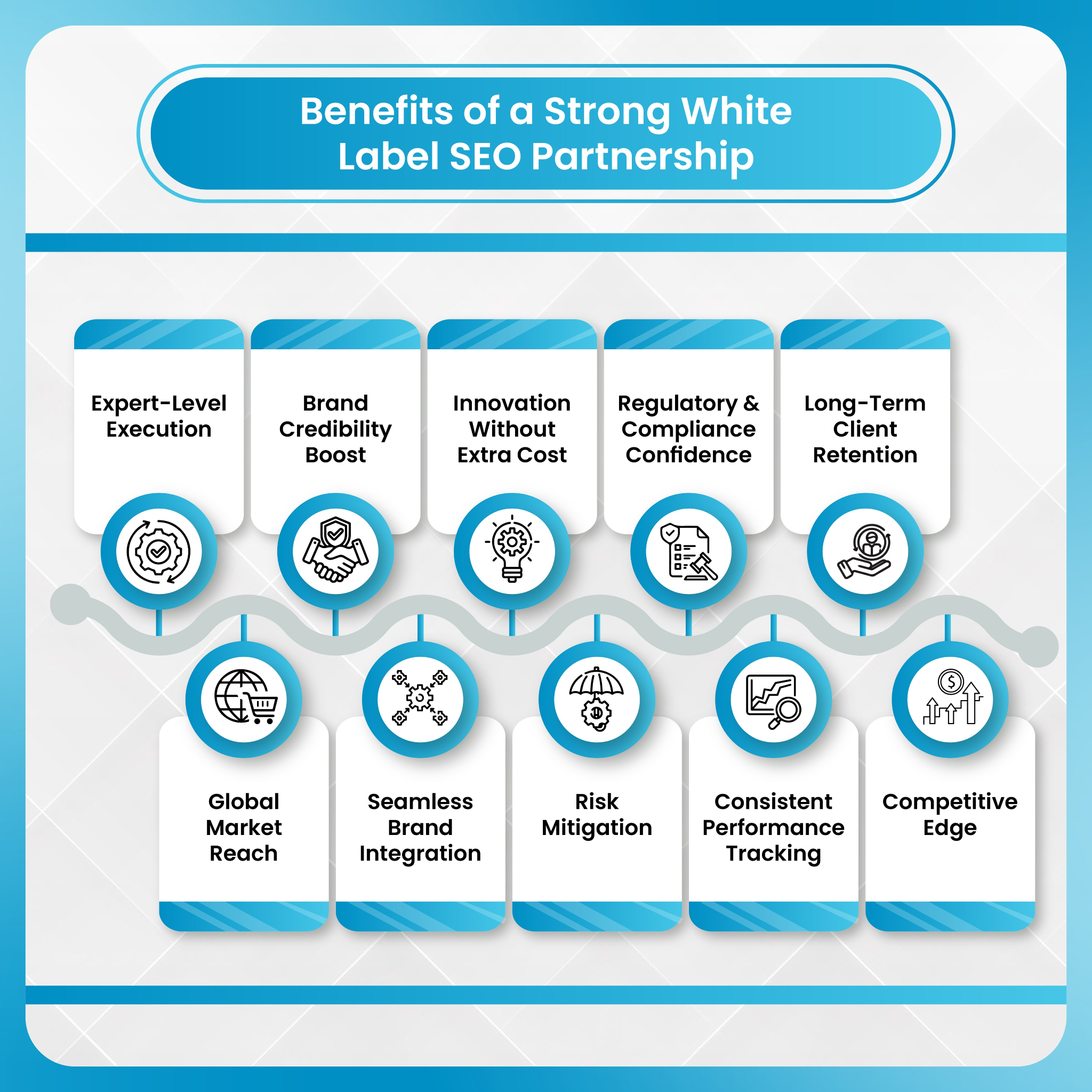
Implementing a 9-Point Playbook for Immediate Impact
To kickstart a robust feedback loop between your team and your white label SEO agency, it’s essential to have a structured plan. The following nine steps provide a clear roadmap for immediate action and long-term results:
1. Establish a Single Source of Truth (SSOT)
Begin by creating a centralized inventory for all SEO-related data, including keywords, content, backlinks, and campaign deliverables. This ensures that both your internal team and your white label provider are working from the same reference point. By eliminating duplicate spreadsheets, conflicting data, or misaligned versions, the SSOT fosters consistency, reduces errors, and allows faster decision-making. Think of it as the master file that captures every insight, change, and result in one place.
2. Assign Roles
Clear accountability is crucial for a smooth feedback loop. Assign specific roles such as:
- Agency Liaison: The main point of contact for client-facing issues, responsible for prioritizing commercial value and communicating expectations to the SEO team.
- Partner Delivery Lead: Oversees execution of SEO tasks, experiments, and revisions based on feedback.
- Data Steward: Maintains the integrity of metrics and ensures that all teams are using consistent definitions for KPIs and other key measurements.
These roles prevent confusion, ensure timely responses, and create a structured chain of ownership for every feedback item.
3. Automate Feedback Collection
Implement tools and integrations that capture feedback automatically. Forms, CRM inputs, and direct integrations with platforms can feed client and internal feedback directly into your SSOT. This reduces the risk of losing insights in emails or ad-hoc messages and ensures that feedback reaches the right person without delay. Real-time capture makes it easier to respond quickly and prioritize effectively.
4. Develop a Triage System
Not all feedback is equal—some items are urgent, others are more experimental. Develop a triage matrix that evaluates each piece of feedback based on its impact (how significantly it affects KPIs) and effort (time or resources required to address it). This approach helps categorize actions into:
- Quick Wins: Easy, high-impact changes.
- Experiments: Medium-impact adjustments to test performance.
- Backlog/R&D: Longer-term initiatives or exploratory ideas.
A triage system ensures the most valuable feedback gets attention first while keeping long-term improvement projects organized.
5. Set Service Level Agreements (SLAs)
To keep the loop running efficiently, define clear SLAs for feedback responses. Establish expectations for:
- Response Time: How quickly feedback should be acknowledged.
- Action Time: How long it takes to implement changes or experiments.
- Closure Criteria: How to know when feedback has been successfully addressed.
SLAs create accountability for both your agency and the SEO provider, preventing feedback from stagnating and improving overall reliability.
6. Conduct Experiments
Turn feedback into measurable improvements through structured experimentation. Start with a small-scale test, such as optimizing a few pages or targeting a specific keyword cluster. Use a clear hypothesis format: "If we implement X, we expect Y metric to improve by Z% in T days."
This controlled approach allows your team to validate changes before rolling them out broadly, minimizing risk while maximizing learning.
7. Utilize AI Tools
AI can significantly streamline feedback processing. AI tools summarizers help condense long client emails, detailed reports, or multi-team comments into actionable insights. This reduces the cognitive load on your team and ensures that no critical point is overlooked. Additionally, AI can help identify recurring patterns in feedback, enabling you to detect underlying issues and opportunities more efficiently.
8. Host Regular Reviews
Schedule monthly outcome reviews with both your internal team and your white label SEO agency. During these sessions:
- Discuss experiments conducted and their results.
- Evaluate KPIs and compare performance against baselines.
- Identify lessons learned and prioritize the next set of actions.
Document all decisions, actions, and insights from these meetings in your SSOT to ensure that knowledge is preserved and shared across teams.
9. Institutionalize Successes
Finally, transform successful experiments and improvements into standardized playbooks. This step ensures that strategies that work for one client or campaign are not lost but instead become repeatable practices across the agency. Over time, institutionalizing successes helps scale your processes, accelerates future wins, and creates a culture of continuous improvement.
Conclusion: Transforming Outsourced SEO into a Strategic Asset
The agencies that scale fastest aren’t just outsourcing work — they’re outsourcing learning. Every campaign, experiment, and insight becomes part of a continuously evolving delivery system.
By investing in structured, transparent feedback loops with a reliable white label SEO partner, you move from reactive management to proactive optimization — achieving faster turnarounds, fewer escalations, and measurable client retention growth.
DashClicks helps agencies bridge that gap — transforming data and feedback into repeatable performance gains. Start with your first SSOT and a single triage meeting — the compounding results will speak for themselves.
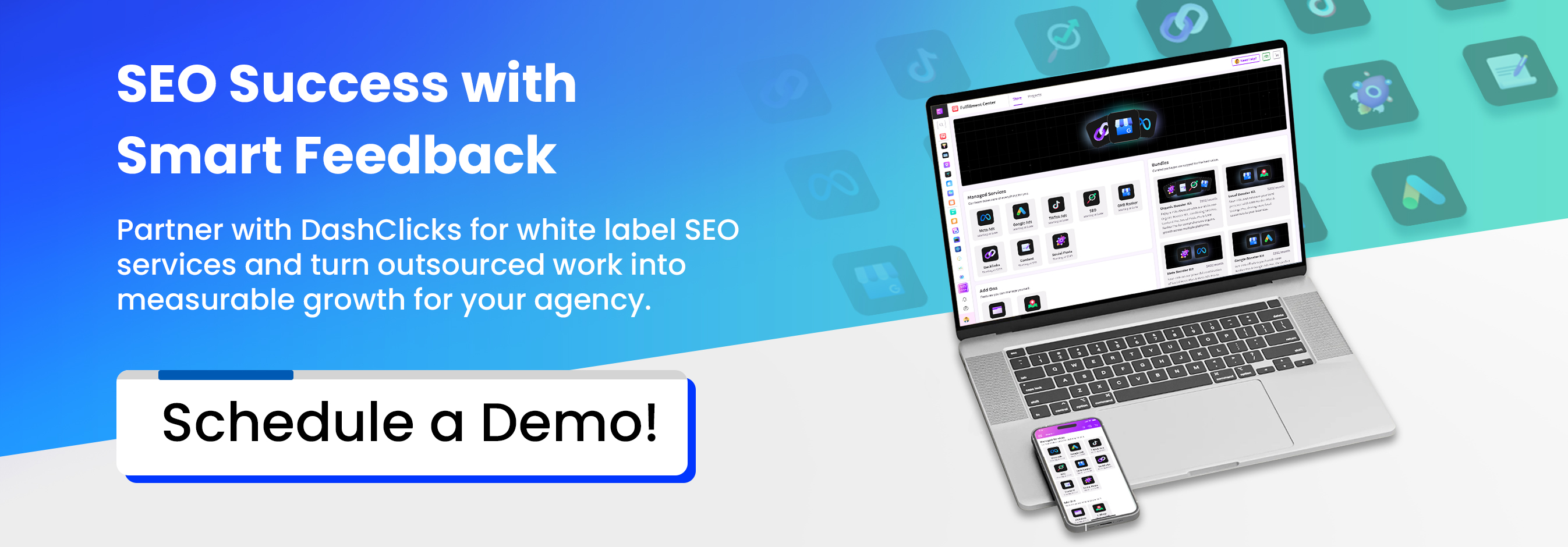


.svg)

.svg)
.svg)
.svg)
.svg)
.svg)

.svg)




.svg)
.svg)
.svg)
.svg)
.svg)